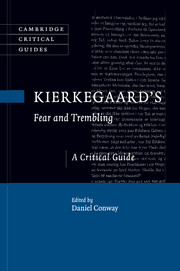Book contents
- Frontmatter
- Contents
- List of Contributors
- Acknowledgments
- List of Abbreviations
- Introduction
- Chapter 1 Homing in on Fear and Trembling
- Chapter 2 Fear and Trembling’s “Attunement” as midrash
- Chapter 3 Johannes de silentio’s dilemma
- Chapter 4 Can an admirer of silentio’s Abraham consistently believe that child sacrifice is forbidden?
- Chapter 5 Eschatological faith and repetition: Kierkegaard’s Abraham and Job
- Chapter 6 The existential dimension of faith
- Chapter 7 Learning to hope: the role of hope in Fear and Trembling
- Chapter 8 On being moved and hearing voices: passion and religious experience in Fear and Trembling
- Chapter 9 Birth, love, and hybridity: Fear and Trembling and the Symposium
- Chapter 10 Narrative unity and the moment of crisis in Fear and Trembling
- Chapter 11 Particularity and ethical attunement: situating Problema III
- Chapter 12 ‘He speaks in tongues’: hearing the truth of Abraham’s words of faith
- Chapter 13 Why Moriah?: weaning and the trauma of transcendence in Kierkegaard’s Fear and Trembling
- Bibliography
- Index
- References
Chapter 10 - Narrative unity and the moment of crisis in Fear and Trembling
Published online by Cambridge University Press: 05 February 2015
- Frontmatter
- Contents
- List of Contributors
- Acknowledgments
- List of Abbreviations
- Introduction
- Chapter 1 Homing in on Fear and Trembling
- Chapter 2 Fear and Trembling’s “Attunement” as midrash
- Chapter 3 Johannes de silentio’s dilemma
- Chapter 4 Can an admirer of silentio’s Abraham consistently believe that child sacrifice is forbidden?
- Chapter 5 Eschatological faith and repetition: Kierkegaard’s Abraham and Job
- Chapter 6 The existential dimension of faith
- Chapter 7 Learning to hope: the role of hope in Fear and Trembling
- Chapter 8 On being moved and hearing voices: passion and religious experience in Fear and Trembling
- Chapter 9 Birth, love, and hybridity: Fear and Trembling and the Symposium
- Chapter 10 Narrative unity and the moment of crisis in Fear and Trembling
- Chapter 11 Particularity and ethical attunement: situating Problema III
- Chapter 12 ‘He speaks in tongues’: hearing the truth of Abraham’s words of faith
- Chapter 13 Why Moriah?: weaning and the trauma of transcendence in Kierkegaard’s Fear and Trembling
- Bibliography
- Index
- References
Summary
A familiar and still influential image of Kierkegaard presents him as an irrationalist; someone who supposes that transitions between evaluative frameworks such as the aesthetic, the ethical, and the religious can only be made by blind “leaps of faith,” acts of will for which no reasons can be given. More recent interpretations of Kierkegaard as a narrative theorist have, I think, successfully challenged this understanding of Kierkegaard’s view of the ethical, but they might seem to leave the irrationalist interpretation of his view of religious faith – particularly as presented in Fear and Trembling – untouched. In this chapter I will argue that faith in Fear and Trembling does have a narrative intelligibility of a kind that is at least partially continuous with that of the ethical life. But I will need to start with a brief explanation of what I mean by narrative intelligibility in the ethical context.
I
Alasdair MacIntyre, who has given one of the more sophisticated versions of the irrationalist reading of Kierkegaard, argues that, according to Kierkegaard, transitions between evaluative frameworks must occur as “criterionless choices,” since they are choices of what will count as being reasons or criteria for actions or choices, and so cannot themselves be governed by (rational) criteria. In the last two or three decades, many Kierkegaard scholars have reacted against such interpretations, arguing in particular that Kierkegaard presents the transition from the aesthetic to the ethical in Either/Or as a rational one. And some of us have argued that, ironically, the account that Kierkegaard has Judge William in Either/Or give of the ethical life and its rationality is very similar to the account MacIntyre himself gives in his After Virtue.
- Type
- Chapter
- Information
- Kierkegaard's Fear and TremblingA Critical Guide, pp. 188 - 204Publisher: Cambridge University PressPrint publication year: 2015
References
- 2
- Cited by



